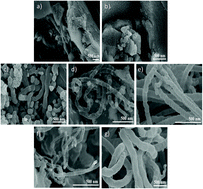Trace metals dramatically boost oxygen electrocatalysis of N-doped coal-derived carbon for zinc–air batteries†
Abstract
The commercialization of metal–air batteries requires efficient, low-cost, and stable bifunctional electrocatalysts for reversible electrocatalysis of the oxygen reduction reaction (ORR) and the oxygen evolution reaction (OER). The modification of natural coal by heteroatoms such as N and S, or metal oxide species, has been demonstrated to form very promising electrocatalysts for the ORR and OER. However, it remains elusive and underexplored as to how the impurity elements in coal may impact the electrocatalytic properties of coal-derived catalysts. Herein, we explore the influence of the presence of various trace metals that are notable impurities in coal, including Al, Si, Ca, K, Fe, Mg, Co, Mn, Ni, and Cu, on the electrochemical performance of the prepared catalysts. The constructed Zn–air batteries are further shown to be able to power green LED lights for more than 80 h. The charge–discharge polarization curves exhibited excellent and durable rechargeability over 500 (ca. 84 h) continuous cycles. The promotional effect of the trace elements is believed to accrue from a combination of electronic structure modification of the active sites, enhancement of the active site density, and formation of a conductive 3-dimensional hierarchical network of carbon nanotubes.



 Please wait while we load your content...
Please wait while we load your content...